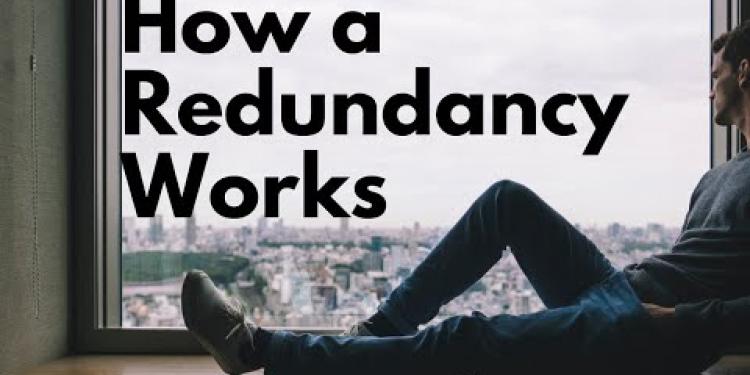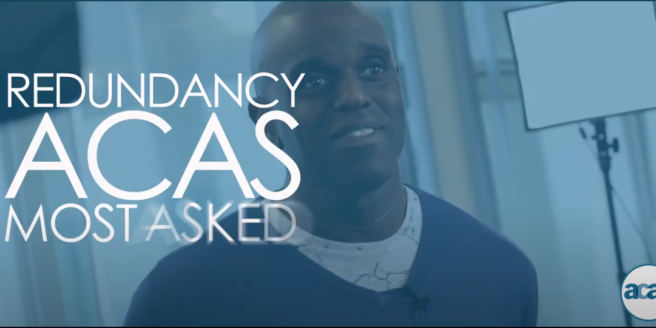Important Information On Using This Service
- Ergsy carefully checks the information in the videos we provide here.
- Videos shown by YouTube after a video has completed have NOT been reviewed by ERGSY.
- To view, click the arrow in the center of the video.
Using Subtitles and Closed Captions
- Most of the videos you find here will have subtitles and/or closed captions available.
- You may need to turn these on and choose your preferred language.
Turn Captions On or Off
- Go to the video you'd like to watch.
- If closed captions (CC) are available, settings will be visible on the bottom right of the video player.
- To turn on captions, click settings.
- To turn off captions, click settings again.
Find A Professional
Redundancy Crusader and Annabel Kaye on Making Redundancy a Better Experience
Understanding the Role of the Redundancy Crusader
The Redundancy Crusader is a pivotal figure in the sphere of employment transition within the United Kingdom. Their primary mission is to mitigate the negative impacts of redundancy on employees. By providing support, resources, and informed advice, the Redundancy Crusader equips individuals with the tools to navigate the often turbulent waters of job loss. This initiative focuses on ensuring workers understand their rights, the redundancy process, and the steps they can take to secure their future employment. Through seminars, workshops, and one-on-one sessions, the Redundancy Crusader aims to transform redundancy from a daunting experience into a manageable transition.Annabel Kaye: A Champion for Employee Rights
Annabel Kaye is a renowned advocate for employee rights and has contributed significantly to reshaping the redundancy experience in the UK. With a background in employment law and extensive experience in HR consultancy, Kaye brings a wealth of knowledge to the table. She emphasizes the importance of transparent communication between employers and employees during the redundancy process. Kaye advocates for fair redundancy packages, psychological support, and the provision of career counseling services. Her work highlights the necessity of compassion and fairness, ensuring that employees are treated with dignity and respect as they transition out of their roles.Strategies for a Better Redundancy Experience
Both the Redundancy Crusader and Annabel Kaye agree that a better redundancy experience starts with preparation and support. Here are some key strategies: 1. **Transparent Communication:** Keeping employees informed about the process, reasons for redundancy, and their rights is crucial. 2. **Support Systems:** Implementing robust support systems like counseling services, job placement assistance, and financial advice can alleviate the stress of redundancy. 3. **Skill Development:** Offering training programs can help redundant employees acquire new skills, making them more marketable in the job hunt. 4. **Fair Packages:** Ensuring redundancy packages are fair and legally compliant provides financial relief during the transition period. 5. **Legal Guidance:** Access to legal advice helps employees understand their entitlements and safeguards their rights.Conclusion
Navigating redundancy is challenging, but with the guidance of the Redundancy Crusader and advocates like Annabel Kaye, the experience can be significantly improved. Their combined efforts focus on providing necessary support, fostering transparent communication, and upholding fair practices, ensuring that employees facing redundancy can do so with confidence and dignity. In the evolving landscape of employment, these initiatives are crucial for fostering a humane and supportive approach to redundancy in the United Kingdom.Redundancy Crusader and Annabel Kaye: Helping People with Job Loss
What Does the Redundancy Crusader Do?
The Redundancy Crusader is a helpful person who supports people when they lose their jobs in the UK. Their main job is to help people feel less upset about losing their jobs. They give people advice, tools, and help to understand what to do next. They make sure workers know their rights and understand the job loss process. The Redundancy Crusader holds talks, workshops, and one-on-one meetings to help people feel less scared and more in control.Who is Annabel Kaye?
Annabel Kaye fights for workers' rights. She has worked hard to make losing a job a better experience in the UK. Annabel knows a lot about laws that protect workers. She says it is very important for bosses to talk openly to workers when someone may lose their job. Annabel wants bosses to give fair pay packages, emotional support, and career advice to help people who lose their jobs. She believes in treating workers kindly and fairly.How to Make Losing a Job Easier
The Redundancy Crusader and Annabel Kaye say that planning and support make losing a job easier. Here are some tips: 1. **Clear Talk:** It is very important for bosses to explain why someone is losing their job and what rights they have. 2. **Helping Hands:** Bosses should offer help like counseling, job search support, and money advice to reduce stress. 3. **Learn New Skills:** Training can help people learn new things and find new jobs. 4. **Fair Money:** Giving fair and legal pay helps people financially when they lose a job. 5. **Know Your Rights:** Getting legal help can make sure people know what they are allowed to get.Summary
Losing a job is hard, but the Redundancy Crusader and Annabel Kaye can make it better. They help by giving support, encouraging clear talk, and ensuring fairness. With their help, people facing job loss can feel more confident and respected. These initiatives in the UK are important for treating people kindly when they lose jobs. For extra help, people can use tools like: - **Mind mapping apps** for organizing thoughts. - **Audiobooks** or **read-aloud tools** for better understanding.Frequently Asked Questions
What is redundancy?
Redundancy is a form of dismissal from your job, caused by your employer needing to reduce the workforce. This can happen due to various reasons such as company restructuring, cost-cutting measures, or company closure.
What are my rights if I am made redundant?
Employees in the UK have several rights if they are made redundant, including the right to a redundancy payment, the right to a consultation with your employer, the right to notice, and the right to time off to look for a new job or to arrange training.
How is redundancy pay calculated?
Redundancy pay is calculated based on your age, length of service, and your weekly pay, up to a limit. Statutory redundancy pay is capped at 20 years of service, with different rates depending on age: half a week’s pay for each year under 22, a week’s pay for each year between 22 and 40, and one and a half week’s pay for each year over 41.
Can I be made redundant if I am on maternity leave?
You can be made redundant while on maternity leave, but it should not be due to the fact that you are on maternity leave. You have the right to return to your job or an equivalent job with similar terms and conditions.
Do I have to accept the redundancy package offered by my employer?
You do not have to accept the redundancy package offered by your employer if you believe it does not meet the legal requirements or if you think it is unfair. You can seek advice or negotiate for better terms.
Can I appeal against a redundancy decision?
Yes, you can appeal against a redundancy decision if you believe it is unfair. You should first raise your concerns with your employer, and if necessary, you can seek advice from a legal professional or a trade union.
What support can I expect from my employer if I am made redundant?
Your employer should provide support such as reasonable notice, redundancy pay, and possibly help with finding a new job or arranging training. Some employers may offer additional support like counselling or outplacement services.
What is a consultation period in the redundancy process?
A consultation period is a time when your employer should discuss the redundancy with you, explain the reasons for it, and explore any alternatives. The length of the consultation period can vary depending on the number of redundancies being made.
Can voluntary redundancy be an option?
Yes, voluntary redundancy can be an option where employees choose to leave the company in return for a redundancy package. It is often used by employers to avoid compulsory redundancies.
What is the notice period for redundancy?
The notice period for redundancy depends on your length of service. Statutory notice periods are one week if you’ve been employed for between one month and two years, and one week for each year of service if employed between two and 12 years, with a maximum of 12 weeks' notice for 12 years or more.
Can my employer rehire for my position after making me redundant?
If your employer makes you redundant and then hires someone else for the same role, it could be a sign that the redundancy was not genuine. In such cases, you may have grounds to challenge the redundancy decision.
What should I do if I think my redundancy was unfair?
If you believe your redundancy was unfair, you should speak to your employer and seek an explanation. If you are not satisfied, consider seeking advice from a legal professional, a trade union, or the Advisory, Conciliation and Arbitration Service (ACAS). You may also consider making a claim to an employment tribunal.
Can I be made redundant if I have less than two years of service?
Yes, you can be made redundant regardless of the length of service. However, if you have less than two years of service, you may not be entitled to statutory redundancy pay, although other entitlements like notice and consultation still apply.
Do I have to work during my notice period after redundancy?
You may be required to work through your notice period after being made redundant, but this can vary depending on your contract and the agreement with your employer. Sometimes, employers may offer pay in lieu of notice.
Can I claim benefits if I am made redundant?
Yes, if you are made redundant, you may be eligible for certain benefits such as Jobseeker’s Allowance (JSA) or Universal Credit (UC) depending on your circumstances. It’s advisable to contact your local Jobcentre Plus office or visit the government website for more information.
What does redundancy mean?
Redundancy is when a job is no longer needed, and a person is let go from work.
If someone loses their job because of redundancy, it is not their fault.
Sometimes companies need to save money or change what they do, so some jobs go away.
To help understand more, you can talk to someone you trust or use a dictionary.
Redundancy means losing your job because your boss needs to have fewer workers. This can happen if the company changes, needs to save money, or shuts down.
What can I do if I lose my job?
If you lose your job because your company does not need you anymore, it is called being "made redundant." Here is what you can do:
Know your rights: You should check what your rights are. This means finding out what you can get, like money you are owed.
Get advice: You can talk to someone who can help. This can be a friend, family member, or someone at a place like a Citizens Advice Bureau.
Ask for help: If you need, you can ask for help from a union if you are part of one.
Remember, you have the right to understand what is happening, and there are people who can help you.
In the UK, workers have rights if they lose their job because of redundancy. This means:
- They can get a payment called a redundancy payment.
- They can talk to their boss about it. This is called a consultation.
- They have to be told in advance. This is the right to notice.
- They can take time off to find a new job or to get training.
If you need help understanding your rights, you can ask a friend, family member, or a support group to help explain things. Using simple apps or websites can also make information easier to read.
How Do You Work Out Redundancy Pay?
Redundancy pay is money you get when you lose your job because there is no more work. Here is how you can find out how much you will get:
- Check how long you have worked at the company. You need to have worked there for at least 2 years.
- Think about your age. People of different ages might get different amounts.
- Look at your weekly pay before tax. This helps decide the amount you get.
You can use online calculators to help work out your redundancy pay. You can also ask someone to help you if you are not sure.
If you lose your job because of redundancy, you can get some money. This is called redundancy pay. How much money you get depends on three things: your age, how long you worked there, and your weekly pay. There is a limit to how much you can get.
If you worked for up to 20 years, the money you get changes if you are:
- Under 22 years old: Half a week’s pay for each year you worked.
- Between 22 and 40 years old: One week’s pay for each year you worked.
- Over 41 years old: One and a half week’s pay for each year you worked.
If reading is hard for you, you can ask someone to read this with you. Using tools like text-to-speech software can also help.
Can I lose my job if I am on maternity leave?
If you are on maternity leave, your job is safer. But sometimes, if a company needs to make big changes, jobs might be removed.
If this happens to you, the company must treat you fairly and offer other jobs if they can.
If you have trouble reading, you can ask someone you trust to help you. You can also use tools like audiobooks to listen to information.
You can lose your job while you are on maternity leave, but it should not be because you are on maternity leave. You have the right to come back to your job or a similar job with the same pay and rules.
Do I have to take the money my boss gives me if I lose my job?
If you lose your job, your boss might give you some money. This is called a 'redundancy package'.
You do not have to say 'yes' to it right away. Take your time to think about it. Talk to someone you trust, like a family member or a friend.
You can also get help from a professional. They are experts who can give you good advice.
Remember, it is okay to ask questions if you do not understand something.
You do not have to take the money your job is giving you if you lose your job and think it is not fair or not following the rules. You can ask for help or talk to them to try and get a better offer.
Here is something that might help:
- Ask for Help: Talk to someone who knows the rules, like a lawyer or a person who helps with jobs.
- Talk to Your Job: See if you can make a better deal by talking to them.
Can I ask for my job back if they say I am not needed anymore?
If you think losing your job is not fair, you can try to change the decision. First, talk to your boss and tell them your worries. If you need more help, you can ask a lawyer or someone from a work help group for advice.
What help will my boss give me if I lose my job?
If you lose your job, your boss might give you some help.
Here are some ways they can help:
- They might give you money to help you while you look for a new job.
- They could help you write a new CV or resume.
- You may get advice on finding a new job.
- They might tell you about job training programs.
Remember, you can ask your boss about the help they offer.
Your boss should help you if you lose your job. They should tell you early, give you money, and maybe help you find another job or learn new skills. Some bosses might also give extra help like talking to a counselor or services to help you find a job.
What is a consultation period when someone might lose their job?
A consultation period is a time when bosses talk with workers.
They talk about job losses.
This is called redundancy.
The bosses and workers try to find the best way forward.
They hope people can keep their jobs or understand what will happen next.
Tips:
- Ask questions if you don't understand.
- You can bring someone to help you, like a friend or family member.
- Write down what they say to remember it.
A consultation time is when your boss talks to you about losing your job. They will tell you why it is happening and see if there is another way instead. How long this takes depends on how many people are losing their jobs.
Can I choose to leave my job with pay?
Yes, sometimes people can choose to leave their job. This is called voluntary redundancy. They get a package, which means they receive some money for leaving. Companies do this to avoid having to make people leave their job if they don't want to.
How long is the notice before your job ends?
When you lose your job because of redundancy, your boss needs to tell you in advance. This is called a notice period. The notice period depends on how long you have worked there.
1. If you have worked for 1 month to 2 years, you get 1 week’s notice.
2. If you have worked for more than 2 years, you get 1 week’s notice for every year you have worked. But, the most you can get is 12 weeks’ notice.
If reading is hard, there are tools that can help. You can use apps that read text out loud. You can also ask someone to explain the steps to you.
Can my boss give my job to someone else after letting me go?
If you lose your job because the company says they don't need your role anymore, and then they hire someone else for that same job, something might be wrong. You can ask questions to see if this was fair.
What can I do if I think losing my job was not fair?
If you feel losing your job was not fair, here are some things you can do:
- Talk to someone you trust for advice. This could be a family member, friend, or helper.
- Write down why you think it was not fair. This will help you remember the details.
- Find out if there is a special office or person who helps with job problems.
- You can ask for help from a group that helps workers. They can tell you what to do next.
- Use a computer tool to help with reading or writing if you find it hard on your own.
Remember, it is important to get help if you think something is not right.
If you think it was not fair to lose your job, talk to your boss and ask why. If you are still unhappy, you can get help from a lawyer, a trade union, or ACAS (a group that helps with work problems). You can also think about going to a special work court to make a claim.
Can I lose my job if I have worked less than two years?
If you have worked at your job for less than two years, your boss might still let you go. This means you could lose your job.
You should talk to someone who knows the rules about work. They can help you understand what can happen next.
If you know a union, they can also help you understand your rights. Talking to an expert can make things clearer for you.
Yes, you can lose your job because of redundancy no matter how long you have worked there. But if you have worked less than two years, you might not get the extra money called 'redundancy pay.' You still have the right to get a warning and to talk about this.
Do I need to work after I am told my job is ending?
If your job is ending, this is called redundancy. You might wonder if you need to work until your last day.
Here is what you can do:
- Check your work contract. It will tell you what to do.
- Ask your boss what they want you to do.
- Talk to someone in Human Resources (HR). They can help explain things to you.
Helpful tips:
- Use a calendar to mark your last day at work.
- Write down any questions you have and ask someone to help you understand.
- Find a friend or support person to talk to if you feel worried.
When you lose your job, you might still have to work for a little while. This is called your notice period. It depends on what your work contract says and what you and your boss agree on. Sometimes, your boss might give you money instead of making you work during this time.
Can I get some money help if I lose my job?
If you lose your job, you might get some money help. Here's what you can do:
- Visit a local advice center. They can tell you what money help you can get.
- Ask someone you trust to help you fill out forms. Filling forms is easier with help.
Remember, you are not alone. There are people who can help you.
If you lose your job, you might get some help. You can ask for Jobseeker’s Allowance (JSA) or Universal Credit (UC). This depends on your situation. You should talk to the local Jobcentre Plus office or look at the government website to learn more.
Useful Links
Useful links from: HOW A REDUNDANCY WORKS - General Information
- NHS - Redundancy This NHS page provides information on how redundancy can affect mental health and offers advice on coping strategies and support services.
- Citizen's Advice - Redundancy Citizen's Advice offers comprehensive information on redundancy, including rights, redundancy pay, notice periods, and where to get further help.
- Acas - Redundancy Handling Acas provides detailed guidance on redundancy processes, including legal requirements, proper consultations, and handling redundancies fairly.
- Mind - Mental Health and Redundancy Mind, a leading mental health charity in the UK, offers advice on coping with the emotional impact of redundancy and where to find further support.
Useful links from: Redundancy Coaching Couch 2: Redundancy and Passion
- NHS Live Well - Redundancy The NHS Live Well page offers advice on redundancy and its impact on mental health, along with tips for managing stress and staying healthy.
- Mind - Money and Mental Health Mind, a mental health charity, provides resources and guidance on managing the emotional and psychological aspects of financial worries, including those stemming from redundancy.
- Citizens Advice - Redundancy Citizens Advice offers comprehensive information on redundancy rights, processes, and the support available to individuals facing redundancy.
- Samaritans - Whatever you're going through, call us free any time Samaritans provides confidential emotional support for people who are experiencing feelings of distress or despair, including those affected by redundancy.
Useful links from: Redundancy Coaching Couch 4:Redundancy and Language
- NHS - Coping with Redundancy NHS resource on managing and coping with the stress and emotional impact of redundancy.
- Mind - Redundancy Mind charity provides information and support for maintaining your mental health if you’re facing redundancy.
- Citizens Advice - Redundancy Citizens Advice offers practical guidance and advice on redundancy rights and what to do after being made redundant.
- Rethink Mental Illness - Redundancy Rethink Mental Illness provides advice on dealing with redundancy and unemployment, focusing on mental health support.
Useful links from: Redundancy Crusader and Annabel Kaye on scope and scale of redundancy (3).MTS
- Redundancy Crusader - Understanding Redundancies This site provides comprehensive information on the causes and management of redundancies, including legal requirements and best practices.
- Annabel Kaye - Employment Law Specialist Annabel Kaye offers expert advice on employment law, including redundancy processes and policies within the UK.
- NHS Employers - Redundancy and Redeployment NHS Employers provides guidelines and support regarding redundancy and redeployment within the NHS, covering legal aspects and employee support.
- NCVO - Managing Redundancies in Charities The National Council for Voluntary Organisations (NCVO) offers resources and advice on handling redundancies in UK-based charities, ensuring legal compliance and best practices.
Useful links from: Redundancy Coaching Couch 7: Redundancy and Judgement.MTS
- NHS - Coping with Redundancy Learn how to manage and cope with redundancy and its impacts on mental health. This page provides practical steps and resources to help you deal with the changes and emotions that come with job loss.
- Mind - Work Issues Mind, the mental health charity, offers support and advice on dealing with work-related issues including redundancy. They provide various resources and information to help maintain mental well-being during challenging times.
- Samaritans - Job Loss and Financial Worries Samaritans provide emotional support to anyone in distress or struggling to cope, including those facing job loss and financial concerns. Access their services for confidential support and guidance.
- Rethink Mental Illness - Stress at Work Rethink Mental Illness offers information and resources to help manage stress at work and addresses related mental health issues. Find practical advice for coping with redundancy and maintaining your mental health.
Useful links from: Redundancy Crusader and Annabel Kaye on the Current Model of Redundancy (1).MTS
- Redundancy Crusader Redundancy Crusader offers comprehensive support and advice for individuals facing redundancy, including resources for understanding your rights and navigating the redundancy process in the UK.
- Annabel Kaye's Official Website Annabel Kaye is an employment law specialist. Her website provides insights into the current model of redundancy, legal advice, and HR policy updates tailored for UK-based employers and employees.
- NHS - Your Rights at Work The NHS provides essential information on employee rights, including those facing redundancy, focusing on health sector employees but also relevant across other sectors.
- Citizens Advice - Redundancy Citizens Advice offers detailed guidance on redundancy rights, processes, and benefits, tailored for people living in the UK. It includes practical advice on how to deal with redundancy and where to seek further help.
Useful links from: Redundancy Crusader and Annabel Kaye on communications in redundancy (5).MTS
- Redundancy Crusader Redundancy Crusader offers resources and support for professionals facing redundancy. It includes guidance on updating CVs, preparing for interviews, and managing the emotional impact of redundancy.
- NHS - Coping with Redundancy The NHS provides advice on dealing with stress and mental health concerns related to redundancy. It covers practical steps to manage change, seek emotional support, and maintain physical health.
- Mind - Redundancy Mind, a UK-based mental health charity, offers comprehensive advice on handling the psychological impact of redundancy. The site includes coping strategies, financial advice, and resources for finding new work.
- Annabel Kaye - LinkedIn Annabel Kaye is a speaker and consultant with experience in employment law and redundancy issues. Her LinkedIn profile provides insights into her expertise and useful posts on managing redundancy.
Useful links from: Redundancy Coaching Couch 1: Redundancy and Presuppositions
- NHS - Redundancy and mental health NHS resource providing information on the mental health impacts of redundancy, including coping strategies and where to find support.
- Mind - Redundancy UK mental health charity Mind offers advice and support on handling the emotional and psychological effects of redundancy.
- Citizens Advice - Redundancy Citizens Advice provides guidance on the practical aspects of redundancy, including rights, processes, and financial entitlements.
- Samaritans - Help and Support Samaritans offers emotional support for anyone going through a difficult time, including those affected by redundancy, through a helpline and other resources.
Useful links from: Redundancy Coaching Couch 3: States
- NHS - Redundancy The NHS provides resources and advice on coping with redundancy, including information on how to manage stress and where to find additional support.
- Citizens Advice Citizens Advice offers guidance on your rights during redundancy, what your employer has to pay, and how to cope with the emotional and financial impact.
- Mind - Redundancy and Mental Health Mind, a UK-based mental health charity, provides practical advice and support for those dealing with redundancy and its effects on mental well-being.
- Turn2us Turn2us is a national charity that offers information on benefits, grants, and financial assistance available to those experiencing redundancy.
Useful links from: Frequently asked questions about redundancy from ACAS
- ACAS - Redundancy: your rights ACAS provides comprehensive guidance on employee rights during redundancy, including the process, notice periods, and redundancy pay.
- NHS Employers - Redundancy Information NHS Employers offer detailed information on redundancy, tailored specifically for NHS staff, covering statutory rights and support mechanisms.
- Macmillan Cancer Support - Redundancy and Cancer Macmillan Cancer Support provides resources for individuals facing redundancy while dealing with cancer, including emotional and financial guidance.
- Citizens Advice - Redundancy Overview Citizens Advice offers an extensive overview of redundancy, explaining your rights, redundancy pay, and the steps to take if you face redundancy.
Useful links from: Understanding the Impact of Rising Living Costs on Family Welfare
- NHS - Help with Health Costs The NHS provides information on various schemes and benefits available to help people manage rising health-related costs. This includes prescriptions, dental care, eye care, and travel costs.
- Citizens Advice - Cost of Living Support Citizens Advice offers guidance on managing the rising cost of living, including help with bills, benefits, and financial support. This resource can help families understand their entitlements and find support services.
- The Trussell Trust - Find a Foodbank The Trussell Trust works to stop UK hunger and poverty. They provide access to local food banks for those in need, helping families who are struggling with the increased cost of living.
- Turn2us - Benefits Calculator Turn2us offers a comprehensive benefits calculator to help individuals and families determine which state benefits and grants they may be entitled to amidst rising living costs.
More Videos of Interestdiagnosis
Have you found an error, or do you have a link or some information you would like to share? Please let us know using the form below.
- Ergsy carfully checks the information in the videos we provide here.
- Videos shown by Youtube after a video has completed, have NOT been reviewed by ERGSY.
- To view, click the arrow in centre of video.
- Most of the videos you find here will have subtitles and/or closed captions available.
- You may need to turn these on, and choose your preferred language.
- Go to the video you'd like to watch.
- If closed captions (CC) are available, settings will be visible on the bottom right of the video player.
- To turn on Captions, click settings .
- To turn off Captions, click settings again.











